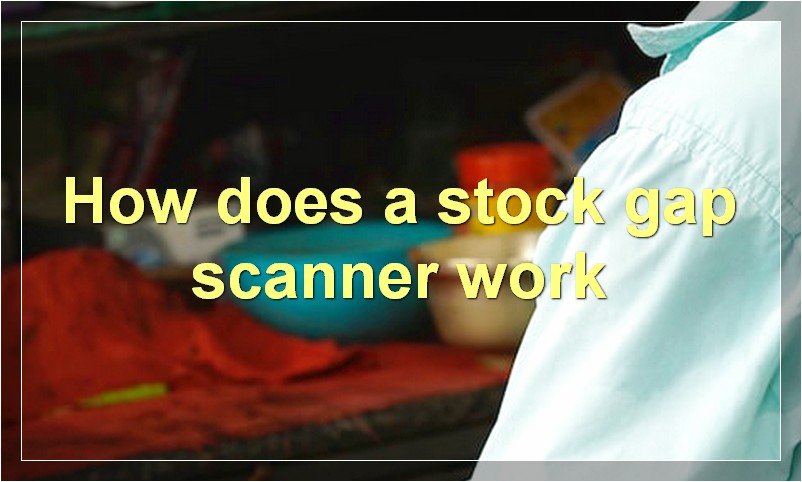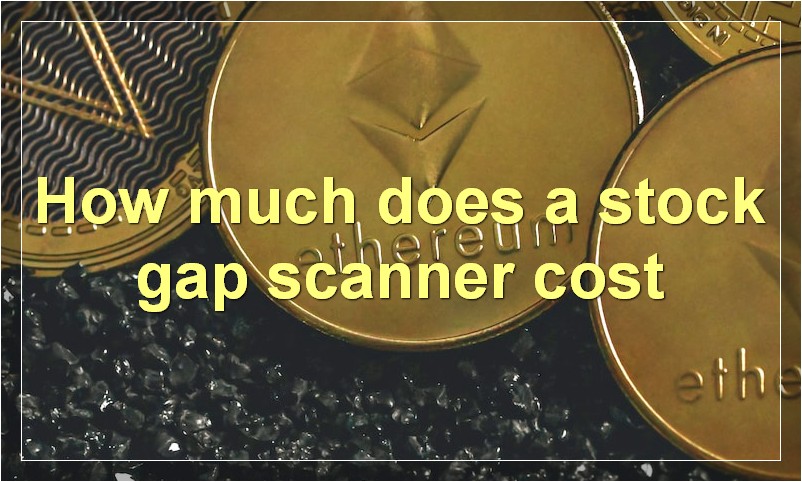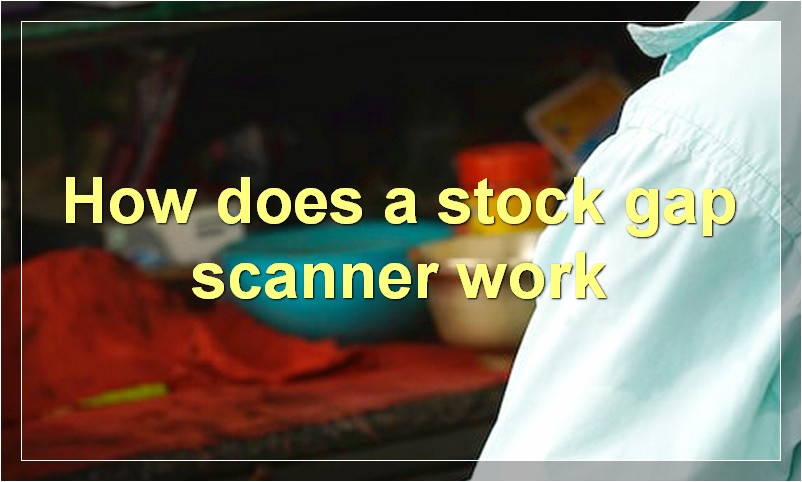If you’re a day trader, then you know the importance of having a stock gap scanner. But what are the benefits of using one? And how much do they cost? In this article, we’ll take a look at the benefits, cost, and use of stock gap scanners.
What is a stock gap scanner
When it comes to stocks, there are a lot of things that can be scanned. But what exactly is a stock gap scanner?
A stock gap scanner is a tool that helps identify stocks that have gaps. These gaps can be created for a variety of reasons, but they typically occur when there is a sudden change in the price of a stock. This can happen due to news events, earnings announcements, or even just changes in market sentiment.
Gaps can provide traders with an opportunity to enter or exit a position at a better price than they would otherwise be able to get. But not all gaps are created equal, and some may be more difficult to trade than others. That’s where a stock gap scanner can come in handy.
There are a number of different scanners out there that can help you find stocks with gaps. Some are free, while others come at a cost. But no matter which one you use, make sure you do your own research before making any trades.
How does a stock gap scanner work

If you’re new to the stock market, you may be wondering how stock gaps work. A stock gap is simply a break in price between two trading periods. For example, if a stock is trading at $10 per share during regular trading hours, but then opens at $12 per share after-hours, there would be a $2 per share gap.
Gaps can occur for a variety of reasons, including news announcements, earnings releases, or even just general market conditions. When a stock gaps up (or down), it’s usually an indication that there is strong demand (or selling pressure) for the stock.
If you’re looking to trade stocks that are gapping up or down, you’ll need to use a stock gap scanner. This is a tool that helps you identify stocks that are gapping up or down in price. There are a variety of different scanners on the market, but they all essentially work in the same way.
To use a scanner, you’ll first need to select the criteria that you’re looking for. For example, you might want to only see stocks that are gapping up by more than $1 per share. Once you’ve selected your criteria, the scanner will then scan the market and identify any stocks that match your criteria.
You can then use the information from the scanner to make informed trades. For example, if you see a stock that’s gapping up by a large amount, you might want to buy shares before the price starts to come back down. Conversely, if you see a stock that’s gapping down sharply, you might want to sell your shares before the price falls any further.
Gap scanners can be extremely useful tools for active traders. If you’re looking to take advantage of stock gaps, be sure to find a scanner that meets your needs.
What are the benefits of using a stock gap scanner
There are a number of benefits to using a stock gap scanner. Perhaps the most obvious benefit is that it can help you find stocks that are gapping up or down. This can be a valuable tool in finding stocks that are potentially undervalued or overvalued. Additionally, a stock gap scanner can help you identify stocks that are experiencing unusual price movements. This can be helpful in finding stocks that may be ripe for a breakout or reversal. Finally, a stock gap scanner can help you keep an eye on the overall market trend. By tracking the gaps of individual stocks, you can get a better sense of whether the market is bullish or bearish.
How can a stock gap scanner help me find profitable trades
A stock gap scanner is a tool that can help you find profitable trades by looking for gaps in the market. This is a useful tool for day traders and investors alike, as it can help you find opportunities to buy or sell stocks that are undervalued or overvalued.
What are the limitations of a stock gap scanner
There are a few limitations to stock gap scanners. First, they can only scan for price gaps. They cannot scan for other conditions such as volume or news. Second, they may not be able to pick up all of the gaps in a stock’s price history. Third, they can only give you a limited amount of information about each gap. For example, a scanner might tell you the size of the gap and the date it occurred, but it will not give you any information about why the gap occurred or whether it is likely to happen again.
How much does a stock gap scanner cost

If you’re looking for a stock gap scanner, you may be wondering how much they cost. The answer varies depending on the features and functionality you need. Some scanners are free, while others can cost hundreds of dollars.
The most important thing to consider when choosing a stock gap scanner is what you need it to do. There are many different scanners on the market, but not all of them will have the features you’re looking for. For example, some scanners only track gaps that have opened in the last 24 hours, while others can track gaps that have opened in the last week or even month.
Once you’ve decided what features you need, you can start comparing prices. Free scanners are a good option if you don’t need any advanced features. However, if you need more than just basic gap scanning, you’ll probably have to pay for a subscription.
Prices for paid scanners vary widely, so it’s important to shop around and compare features before you decide which one to buy. You may also want to look for discounts or special offers from time to time.
Is there a free stock gap scanner
There are many ways to find out if there is a free stock gap scanner. The first way is to ask around. Friends, family, and colleagues may know of a free scanner that you can use. The second way is to check online. A quick search on Google or another search engine should reveal any free scanners that are available. The third way is to contact your broker or financial advisor. They may be able to provide you with a free scanner. Finally, you can always try using a free trial of a paid scanner. This will allow you to test out the features and see if it is worth the investment before you commit to buying it.
Where can I find a stock gap scanner
There are many places you can find a stock gap scanner. One popular place is the website StockCharts.com. They have a variety of different scanners that you can use to scan for gaps in the stock market.
Another popular place to find a stock gap scanner is Finviz.com. They also have a variety of different scanners that you can use to find gaps in the stock market.
If you want to find a stock gap scanner that is specifically designed for finding gaps, you can try GapScans.com. They have a variety of different scanners that you can use to find gaps in the stock market.
What do I need to use a stock gap scanner
In order to use a stock gap scanner, you will need access to a computer with an internet connection and a web browser. You will also need to have a brokerage account set up so that you can trade stocks.
Who makes the best stock gap scanner
There are many different stock gap scanners on the market, and it can be difficult to decide which one is best for you. Here is a breakdown of some of the most popular stock gap scanners to help you make a decision.
The first stock gap scanner we will look at is Trade-Ideas. This scanner is popular among day traders and swing traders alike. It offers a wide variety of features, including real-time alerts, historical data, and customizable parameters. The scanner can be used to find stocks that are gapping up or down, as well as those that are about to breakout or reverse.
Next, we have Finviz. This scanner is also very popular among traders of all types. It offers a user-friendly interface and a wide range of features, including pre-market and after-hours scanning, news integration, and technical analysis tools. Finviz is a great choice for both beginners and experienced traders.
Last but not least, we have StockCharts. This scanner is geared more towards technical traders. It offers a wealth of technical indicators and charting tools, as well as real-time news and data. StockCharts is an excellent choice for those who want to do a lot of technical analysis before making trading decisions.
So, who makes the best stock gap scanner? That depends on your individual needs and preferences. All three of these scanners are highly rated and offer a lot of features. If you need help deciding, feel free to reach out to our team of experts for assistance.

